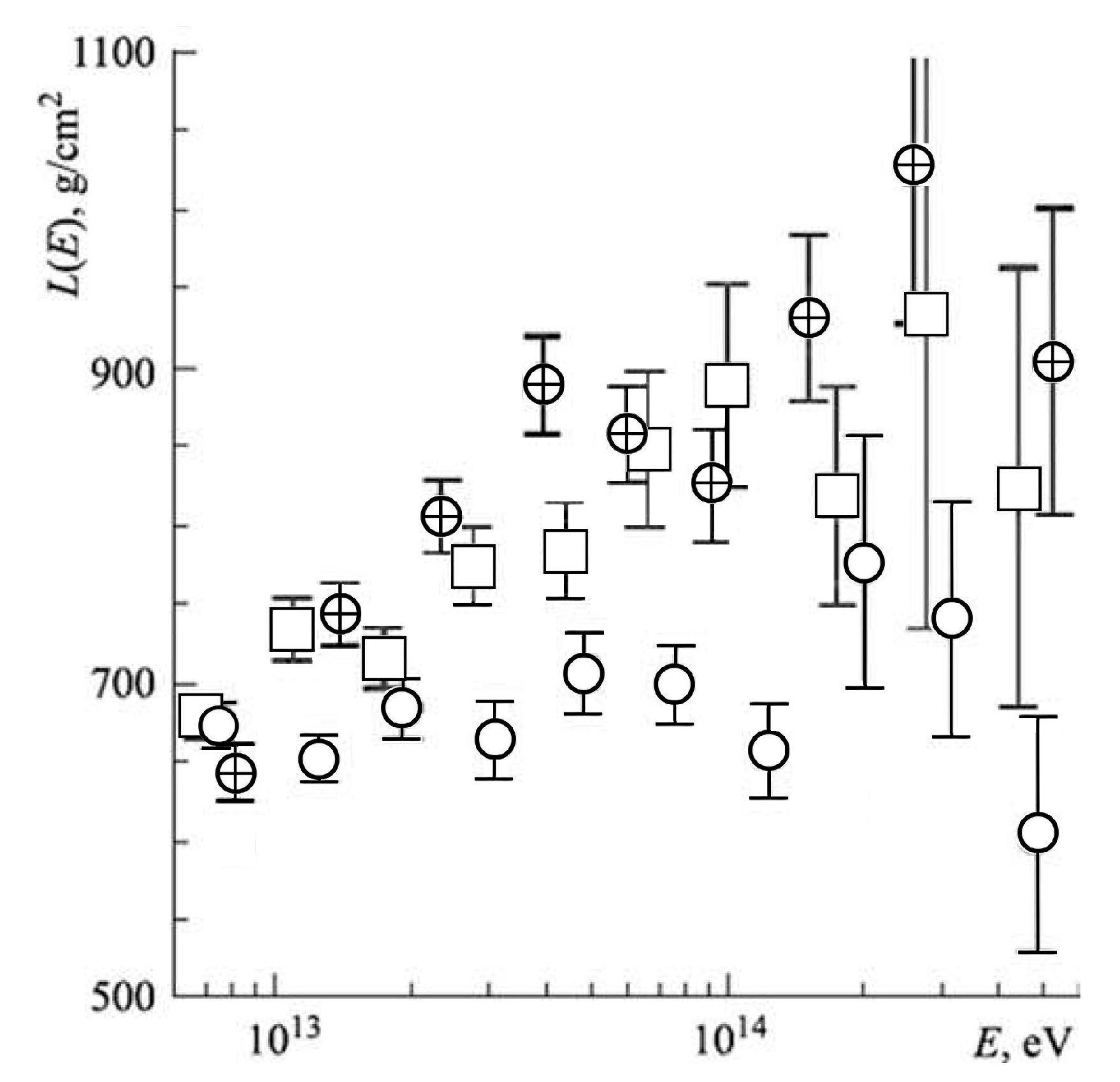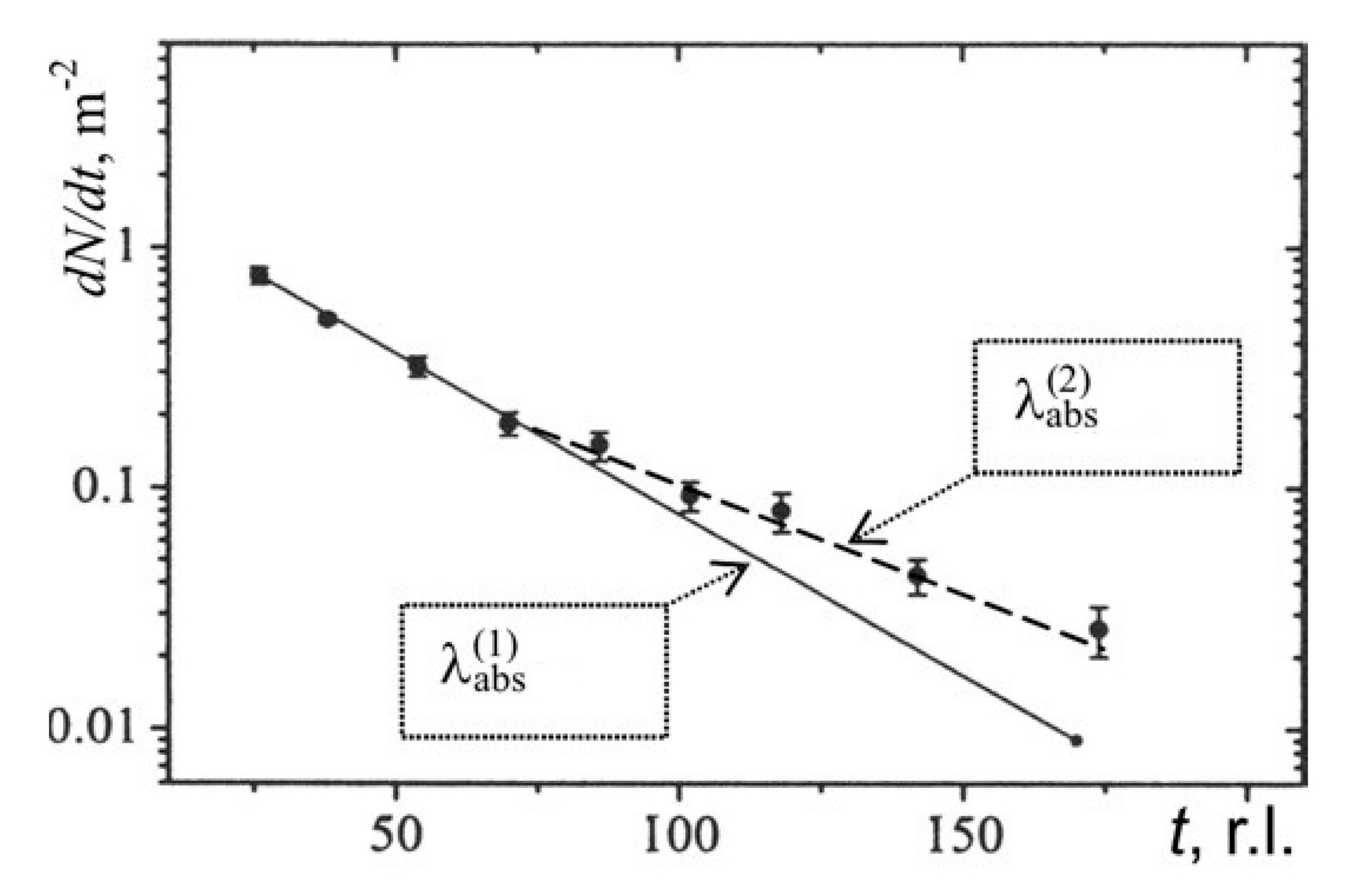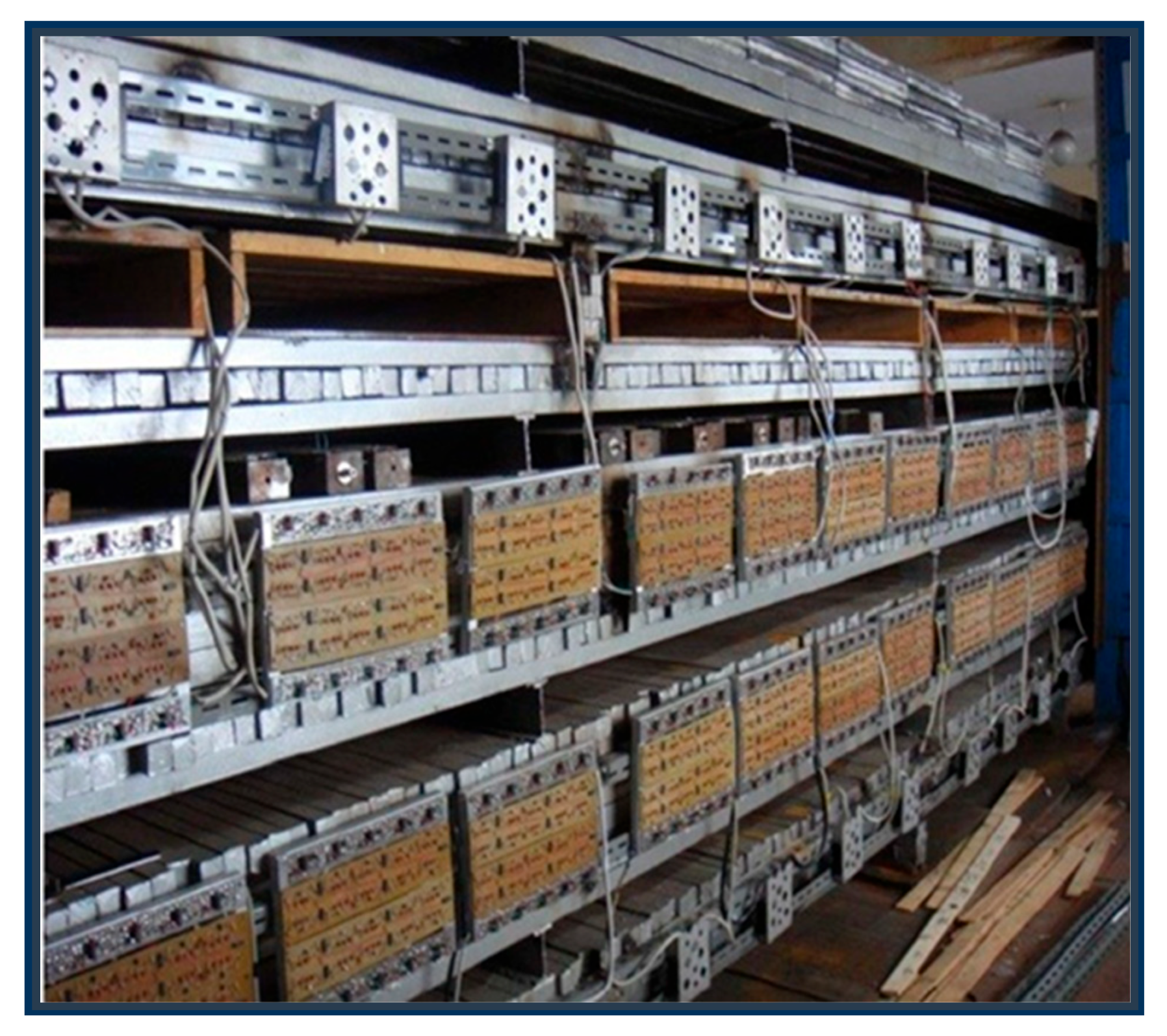Studies of Anomalous Phenomena in the Development of Electron-Nuclear Cascades in the EAS Cores Registered by a Modernized Complex Installation at Mountain Altitudes
Abstract
:1. Introduction
2. «Hadron-M» Complex Installation
2.1. Ionization-Neutron Calorimeter
2.2. Registration and Analysis of “Hadron-M” Experimental Data
3. Conclusions
Funding
Institutional Review Board Statement
Informed Consent Statement
Data Availability Statement
Conflicts of Interest
References
- Amineva, T.P.; Glavach, T.G.; Aseikin, V.S.; Vavilov, Y.N. Installation for studying extensive air showers and nuclear interactions of cosmic-radiation particles with an energy of 1012–1016 eV. Trudy FIAN 1970, 46, 157. (In Russian) [Google Scholar]
- Aseikin, V.S.; Bobova, V.P.; Goryacheva, G.Y.; Nikolsky, S.I.; Yakovlev, V.I. Absorption of the energy flux in the cores of extensive air showers. Izv. AN USSR 1974, 38, 998–1002. (In Russian) [Google Scholar]
- Yakovlev, V.I. Long flying component: Recent data and interpretation. AIP Conf. Proc. 1993, 276, 154. [Google Scholar]
- Nikolsky, S.I.; Yakovlev, V.I.; Pavljuchenko, V.P. Hadronic Cascades with Anomalous Absorption in the Lead. In Proceedings of the 15-th International Cosmic Ray Conf., Plovdiv, Bulgaria, 13–26 August 1977; Volume 8, p. 130. [Google Scholar]
- Nikolskaya, N.M.; Pavlyuchenko, V.P.; Yakovlev, V.I. Parameters of High Energy Cores of EAS Detected with the Large Ionization Calorimeter on Tien Shan Mountain Station; P.N. Lebedev Physical Institute: Moscow, Russia, 1989. (In Russian) [Google Scholar]
- Borisov, A.S.; Chubenko, A.P.; Denisova, V.G.; Galkin, V.I.; Guseva, Z.M.; Kanevskaya, E.A.; Kogan, M.G.; Kulikov, V.N.; Morozov, A.E.; Mukhamedshin, R.A.; et al. Study of charm production in the forward cone at energy E Lab > 75 TeV with a two-storey X-ray emulsion chamber exposed at mountain altitudes. EPJ Web Conf. 2015, 99, 10004. [Google Scholar] [CrossRef] [Green Version]
- Dremin, I.M.; Madigozhin, D.T.; Yakovlev, V.I. Monte Carlo simulations of long-flying cascades in cosmic rays and leading charm at SSC. AIP Conf. Proc. 1993, 276, 534. [Google Scholar]
- Bayburina, S.G.; Borisov, A.S.; Cherdyntseva, K.V.; Guseva, Z.M.; Denisova, V.G.; Dunaevskii, A.M.; Kanevskaya, E.A.; Maxsimenko, V.M.; Pashkov, S.V.; Shaulov, S.B.; et al. Investigation of nuclear interactions in the energy range 1014–1017 eV by the method of X-ray emulsion chambers in cosmic rays (Pamir experiment). Trudy FIAN 1984, 154, 3–141. (In Russian) [Google Scholar]
- Rakobolskaya, I.V.; Roganova, T.M.; Sveshnikova, L.G. Energy dependence of charm production cross section at high energies. Nucl. Phys. B (Proc. Suppl.) 2003, 122, 353–356. [Google Scholar] [CrossRef]
- Sveshnikova, L.G.; Chubenko, A.P.; Mukhamedshin, R.A.; Popova, N.S.; Nikolskaya, N.M.; Yakovlev, V.I. On abnormal absorption of hadron component of EAS cores in lead and possible explanations. arXiv 2007, arXiv:0701219. [Google Scholar]
- The Pamir Collaboration. Search for events with coplanar divergence of super high energy particles. In Proceedings of the 4th International Symposium on Very High Energy Cosmic Ray Interactions, Beijing, China, 29 October–3 November 1986; pp. 429–437. [Google Scholar]
- Kopenkin, V.V.; Managadze, A.K.; Rakobolskaya, I.V.; Roganova, T.M. Alignment in γ-hadron families of cosmic rays. Phys. Rev. D 1995, 52, 2766–2774. [Google Scholar] [CrossRef] [Green Version]
- Borisov, A.S.; Mukhamedshin, R.A.; Puchkov, V.S.; Slavatinsky, S.A.; Zdanov, G.B. On the nature of gamma-hadron family alignment. Nucl. Phys. B (Proc. Suppl.) 2001, 97, 118–121. [Google Scholar] [CrossRef]
- Xue, L.; Dai, Z.Q.; Li, J.Y. Study on alignment of high energy γ-hadron family events with iron emulsion chambers. In Proceedings of the 26th International Cosmic Ray Conf., Salt Lake City, UT, USA, 17–25 August 1999; Volume 1, pp. 127–130. [Google Scholar]
- Pamir Collaboration. Alignment of Cores Distinguished for Energies in Superfamilies; SINP MSU: Moscow, Russia, 1989; 13p. [Google Scholar]
- Borisov, A.S.; Guseva, Z.M.; Denisova, V.G.; Mukhamedshin, R.A.; Puchkov, V.S.; Slavatinsky, S.A.; Smirnova, M.D.; Smorodin, Y.A.; Zhdanov, G.B. Coplanar emission of high energy particles in super-families with total gamma-quantum energy exceeding 400 TeV. In Proceedings of the 8th International Simp. Very High Energy Cosmic Ray Interactions, Tokyo, Japan, 24–30 July 1994; pp. 49–56. [Google Scholar]
- Managadze, A.K.; Osedlo, V.I.; Roganova, T.M.; Sveshnikova, L.G.; Galkin, V.I.; Rakobolskaya, I.V.; Goncharova, L.A.; Kotelnikov, K.A.; Polukhina, N.G. Large transverse momenta in nuclear interaction at E0 > 1016 eV detected in stratosphere. Phys. At. Nucl. 2007, 70, 184–190. [Google Scholar] [CrossRef]
- Apanasenko, A.V.; Dobrotin, N.A.; Goncharova, L.A.; Kotelnikov, K.A. Stratospheric superfamily with ΣEγ~2·1015 eV. In Proceedings of the 15th International Cosmic Ray Conference, Plovdiv, Bulgaria, 13–26 August 1977; Volume 7, pp. 220–225. [Google Scholar]
- Osedlo, V.I.; Rakobolskaya, I.V.; Galkin, V.I.; Managadze, A.K.; Sveshnikova, L.G.; Goncharova, L.A.; Kotelnikov, K.A.; Martynov, A.G.; Polukhina, N.G. A superfamily with ΣEγ > 1015 eV observed in stratosphere. In Proceedings of the 27th International Cosmic Ray Conference, Hamburg, Germany, 8–15 August 2001; Volume 4, pp. 1426–1429. [Google Scholar]
- Capdevielle, J.N.; Talai, M.C.; Attallah, R. Remarkable events from X-ray emulsion chambers and multiple production at LHC energy. In Proceedings of the 30th International Cosmic Ray Conference, Merida, Mexico, 3–11 July 2007; Volume 4, pp. 651–654. [Google Scholar]
- Capdevielle, J.N.; Attallah, R.; Talai, M.C. Coplanar emission in gamma ray families, geometrical and dynamical coincidence or new mechanism? In Proceedings of the 27th International Cosmic Ray Conference, Hamburg, Germany, 8–15 August 2001; Volume 1, pp. 1410–1413. [Google Scholar]
- Azimov, S.A.; Mulladjanov, E.G.; Nuritdinov, K.; Yuldashbaev, T.S. Azimuthal effects in hadron and photon families. In Proceedings of the 18-th International Cosmic Ray Conference, Bangalore, India, 22 August–3 September 1983; Volume 5, pp. 458–461. [Google Scholar]
- Yuldashbaev, T.S.; Nuritdinov, K.; Nosov, A.N. Azimuthal correlation peculiarities in gamma families with energies ΣEγ = 100–2000 TeV. In Proceedings of the 26th International Cosmic Ray Conference, Salt Lake City, UT, USA, 17–25 August 1999; Volume 1, pp. 76–79. [Google Scholar]
- The Pamir Collaboration. The azimuthal structure of gamma-families in the Pamir experiment. In Proceedings of the 17th International Cosmic Ray Conference, Paris, France, 13–25 July 1981; Volume 11, pp. 156–158. [Google Scholar]
- Pavlyuchenko, V.P. Study of the alignment effect in high-energy nuclear interactions with an ionization calorimeter. Bull. Lebedev Phys. Inst. 1998, 6, 1–7. [Google Scholar]
- Mukhamedshin, R.A. On coplanarity of most energetic cores in gamma-ray-hadron families and hadron interactions at √s > 4 TeV. J. High Energy Phys. 2005, 5, 49. [Google Scholar] [CrossRef] [Green Version]
- Mukhamedshin, R.A. Simulation of coplanar particle generation in hadron interactions at superhigh energies by the new FANSY 1.0 code. Nucl. Phys. B (Proc. Suppl.) 2009, 196, 98. [Google Scholar] [CrossRef]
- Mukhamedshin, R.A. FANSY 1.0: A phenomenological model for simulation of coplanar particle generation in superhigh-energy hadron interactions. Eur. Phys. J. C 2009, 60, 345–358. [Google Scholar] [CrossRef] [Green Version]
- Mukhamedshin, R.A. On alignment of most energetic substructures of γ-ray-hadron families and hadron interactions at E0 > 1016 eV. In Proceedings of the 29th International Cosmic Ray Conference, Pune, India, 3–10 August 2005; Volume 5, p. 448. [Google Scholar]
- Wibig, T. Alignment in hadronic interactions. arXiv 2000, arXiv:0003230. [Google Scholar]
- Royzen, I.I. Theoretical approach to alignment phenomenon. Mod. Phys. Lett. A 1994, 9, 3517–3522. [Google Scholar] [CrossRef] [Green Version]
- Yuldashbaev, T.S.; Nuritdinov, K.; Chudakov, V.M. Unusual family characteristics at energies above 10 PeV. Nuovo Cim. 2001, 24, 569–572. [Google Scholar]
- Mukhamedshin, R.A. On a mechanism of coplanar generation of particles at superhigh energies. Nucl. Phys. B (Proc. Suppl.) 1999, 75, 141–144. [Google Scholar] [CrossRef] [Green Version]
- Halzen, F.; Morris, D.A. Collinear halos. Phys. Rev. D. 1990, 42, 1435–1438. [Google Scholar] [CrossRef]
- Anchordoqui, L.A.; Dai, D.C.; Goldberg, H.; Landsberg, G.; Shaughnessy, G.; Stojkovic, D.; Weiler, T.J. Searching for the Layered Structure of Space at the LHC. Phys. Rev. D 2011, 83, 114046. [Google Scholar] [CrossRef] [Green Version]
- Anchordoqui, L.A.; Dai, D.C.; Fairbairn, M.; Landsberg, G.; Stojkovic, D. Vanishing Dimensions and Planar Events at the LHC. Mod. Phys. Lett. A 2012, 27, 1250021. [Google Scholar] [CrossRef] [Green Version]
- Stojkovic, D. Vanishing Dimensions: A Review. Mode. Phys. Lett. A 2013, 28, 1330034. [Google Scholar] [CrossRef] [Green Version]
- Nesterova, N.M.; Chubenko, A.P.; Djatlov, P.A.; Vildanova, L.I. The primary cosmic ray spectrum at 2⋅1013–2⋅1018 eV and its peculiarity above 1018 eV according to Tien Shan data. In Proceedings of the 24th International Cosmic Ray Conf., Roma, Italy, 28 August–8 September 1995; Volume 2, pp. 157–159. [Google Scholar]
- Takibaev, Z.S.; Baigubekov, A.S.; Sadykov, T.K. Accelerated search for families of gamma quanta in an X-ray emulsion chamber. PTE 1977, 3, 70–71. [Google Scholar]
- Babaev, M.K.; Baigubekov, A.S.; Sadykov, T.K. Analysis of nuclear-electronic cascades formed by hadrons of cosmic rays in the energy region E3≥1013 eV. NEWS Natl. Acad. Sci. Repub. Kazakhstan 2001, 6, 53–56. (In Russian) [Google Scholar]
- Eremenko, Y.A.; Kalinin, Y.G.; Martyanov, I.S.; Sadykov, T.K.; Zastrozhnova, N.N. Multi-channel analog processor with 5·105 dynamic range for registration of interaction at super-high energies in the cosmic rays. Nuclear Instr. Meth. Phys. Res. A 2001, 459, 273–277. [Google Scholar] [CrossRef]
- Alibekov, M.E.; Babaev, M.K.; Baigubekov, A.S.; Sadykov, T.K. Simulation of the processes of passage of various particles through the atmosphere and the experimental setup “Hadron-44”. In Nuclear Interactions of Particles of High and Ultrahigh Energies; Science: Alma-Ata, Kazakhstan, 1989; pp. 21–30. (In Russian) [Google Scholar]
- Kalinin, Y.G.; Martyanov, I.S.; Sadykov, T.K.; Zastrognova, N.N. The simple method to adapt time sampling of the analog signal. Nucl. Instr. Meth. Phys. Res. A 2004, 524, 374–376. [Google Scholar] [CrossRef]
- Sadykov, T.K.; Dalkarov, O.D.; Ryabov, V.A. Hadron-55 complex setup for study of hadron interactions within the central part of EAS. In Proceedings of the 34th International Cosmic Ray Conference, Hague, The Netherlands, 30 July–6 August 2015; Available online: http://pos.sissa.it/archive/conferences/236/570/ICRC2015_570.pdf (accessed on 3 February 2023).
- Idrissova, T.; Sadykov, T.; Burtebayev, N.; Ryabov, V.; Zhukov, V. Complex installation Hadron-55 for registration of wide atmospheric showers. Acta Phys. Pol. B (Proc. Suppl.) 2021, 14, 681–686. [Google Scholar] [CrossRef]
- Sadykov, T.K.; Argynova, A.K.; Jukov, V.V.; Novolodskaia, O.A.; Piskal’, V.V. Modernization of the peripheral detectors of Tien-Shan ionization-neutron calorimeter detectors “Hadron-55”. News Natl. Acad. Sci. Repub. Kazakhstan 2021, 4, 121–128. (In Russian) [Google Scholar] [CrossRef]
- Mukashev, K.; Argynova, A.; Zhukov, V.; Idrissova, T.; Iskakov, B.; Piskal, V.; Sadykov, T.; Sadykov, Z.; Stepanov, A.; Serikkanov, A. The Complex of Experimental Facilities for the Cosmic Ray Investigation at the Tien Shan Mountain Station. Appl. Sci. 2022, 12, 465. [Google Scholar] [CrossRef]
- Mukashev, K.M.; Sadykov, T.K. Physics, Astrophysics of Cosmic rays and Anomalous Effects in Hadron Interactions; Almatykitap: Almaty, Kazakhstan, 2011; p. 375. ISBN 978-601-232-538-6. (In Russian) [Google Scholar]
- Chubenko, A.P.; Shepetov, A.L.; Antonova, V.P. The modern status of anomalous delayed particles effect in the “Knee” region EAS according to the data of Tien Shan mountain station. In Proceedings of the 28th International Cosmic Ray Conference, Tsukuba, Japan, 31 July–7 August 2003; pp. 69–72. [Google Scholar]
- Baigubekov, A.S.; Beisembaev, R.Y.; Sadykov, T.K. Anomalously delayed particles in extensive air shower core according to result of the new plant. In Proceedings of the 28th International Cosmic Ray Conference, Tsukuba, Japan, 31 July–7 August 2003; Volume 6, pp. 61–64. [Google Scholar]
- Argynova, A.K.; Iskakov, B.; Jukov, V.V.; Mukashev, K.M.; Muradov, A.D.; Piskal, V.V.; Saduyev, N.O.; Sadykov, T.X.; Salihov, N.M.; Serikkanov, A.S.; et al. The perspective fundamental cosmic rays physics and astrophysics investigations in the Tien-Shan high-mountain scientific station. News Natl. Acad. Sci. Repub. Kazakhstan 2019, 6, 121–138. [Google Scholar] [CrossRef]
- Mukashev, K.M.; Argynova, A.K.; Beisenova, A.D.; Iskakov, B.A.; Mukhamedshin, R.A.; Novolodskaya, O.A.; Piskal, V.V.; Ryabov, V.A.; Sadykov, T.K.; Serikkanov, A.S.; et al. Search for structures in the distribution of particles from the central area of wide atmospheric showers conducted on the Adron-55 installation. Phys. Sci. Technol. 2019, 6, 75–83. [Google Scholar] [CrossRef]
- Slavatinsky, S.A. Results of emulsion chamber experiments with very high-energy cosmic rays which are difficult to explain in the framework of the standard model. Nucl. Phys. B Proc. Suppl. 2003, 122, 3–11. [Google Scholar] [CrossRef]
- Witten, E. Cosmic separation of phases. Phys. Rev. D 1984, 30, 272–285. [Google Scholar] [CrossRef]
- Shaulov, S.B. Nuclear-Physics Model of the Knee in the EAS Spectrum. Phys. At. Nucl. 2018, 81, 638. [Google Scholar] [CrossRef]
- Bucciantini, N.; Drago, A.; Pagliara, G.; Traversi, S.; Bauswein, A. Formation and evaporation of strangelets during the merger of two compact stars. Phys. Rev. D 2022, 106, 103032. [Google Scholar] [CrossRef]
- Gladysz-Dziadus, E. Are Centauros exotic signals of the quark-gluon plasma? Phys. Part. Nucl. 2003, 34, 285–347. [Google Scholar]
- Kulikov, G.V.; Khristiansen, G.B. On the size spectrum of extensive air showers. Sov. Phys. JETP 1959, 35, 441–444. [Google Scholar]
- Iskakov, B.A.; Argynova, A.K.; Beisenova, A.D.; Zhautykov, B.O.; Idrisova, T.K.; Novolodskaya, O.A.; Piscal, V.V.; Ryabov, V.A.; Sadykov, T.K.; Sadykov, J.T.; et al. “HADRON-55” complex setup for study of hadron interactions within the central part of cosmic ray extensive air showers (EAS) cores. J. Instrum. 2020, 15, 12002. [Google Scholar] [CrossRef]
- The CMS Collaboration. The very forward CASTOR calorimeter of the CMS experiment. J. Instrument. 2021, 16, P02010. [Google Scholar] [CrossRef]
- The CMS Collaboration; TOTEM Collaboration. Measurement of pseudorapidity distributions of charged particles in proton-proton collisions at √s = 8 TeV by the CMS and TOTEM experiments. Eur. Phys. J. C 2014, 74, 2053. [Google Scholar]
- The LHCf Collaboration. The results from LHCf and future prospects. EPJ Web Conf. 2013, 52, 01007. [Google Scholar] [CrossRef]
- The FASER Experiment. Available online: https://faser.web.cern.ch/physics (accessed on 6 February 2023).
- Shaulov, S.B.; Beyl, P.F.; Beysembaev, R.U.; Beysembaeva, E.A.; Bezshapov, S.P.; Borisov, A.S.; Cherdyntceva, K.V.; Chernyavsky, M.M.; Chubenko, A.P.; Dalkarov, O.D.; et al. Investigation of EAS cores. EPJ Web Conf. 2017, 145, 17001. [Google Scholar] [CrossRef]
- Mukhamedshin, R.A. On connection between the collider long-range near-side “ridge” effect at |η| < 2.4 and cosmic-ray coplanarity of most energetic particles. Eur. Phys. J. C 2022, 82, 155. [Google Scholar] [CrossRef]






Disclaimer/Publisher’s Note: The statements, opinions and data contained in all publications are solely those of the individual author(s) and contributor(s) and not of MDPI and/or the editor(s). MDPI and/or the editor(s) disclaim responsibility for any injury to people or property resulting from any ideas, methods, instructions or products referred to in the content. |
© 2023 by the authors. Licensee MDPI, Basel, Switzerland. This article is an open access article distributed under the terms and conditions of the Creative Commons Attribution (CC BY) license (https://creativecommons.org/licenses/by/4.0/).
Share and Cite
Mukhamedshin, R.; Sadykov, T.; Serikkanov, A.; Argynova, A.; Iskakov, B.; Argynova, K.; Mahmet, H.; Novolodskaya, O.; Idrissova, T.; Zhukov, V.; et al. Studies of Anomalous Phenomena in the Development of Electron-Nuclear Cascades in the EAS Cores Registered by a Modernized Complex Installation at Mountain Altitudes. Appl. Sci. 2023, 13, 2507. https://doi.org/10.3390/app13042507
Mukhamedshin R, Sadykov T, Serikkanov A, Argynova A, Iskakov B, Argynova K, Mahmet H, Novolodskaya O, Idrissova T, Zhukov V, et al. Studies of Anomalous Phenomena in the Development of Electron-Nuclear Cascades in the EAS Cores Registered by a Modernized Complex Installation at Mountain Altitudes. Applied Sciences. 2023; 13(4):2507. https://doi.org/10.3390/app13042507
Chicago/Turabian StyleMukhamedshin, Rauf, Turlan Sadykov, Abay Serikkanov, Alia Argynova, Bakhtiar Iskakov, Korlan Argynova, Hanshain Mahmet, Olga Novolodskaya, Tunyk Idrissova, Valery Zhukov, and et al. 2023. "Studies of Anomalous Phenomena in the Development of Electron-Nuclear Cascades in the EAS Cores Registered by a Modernized Complex Installation at Mountain Altitudes" Applied Sciences 13, no. 4: 2507. https://doi.org/10.3390/app13042507





